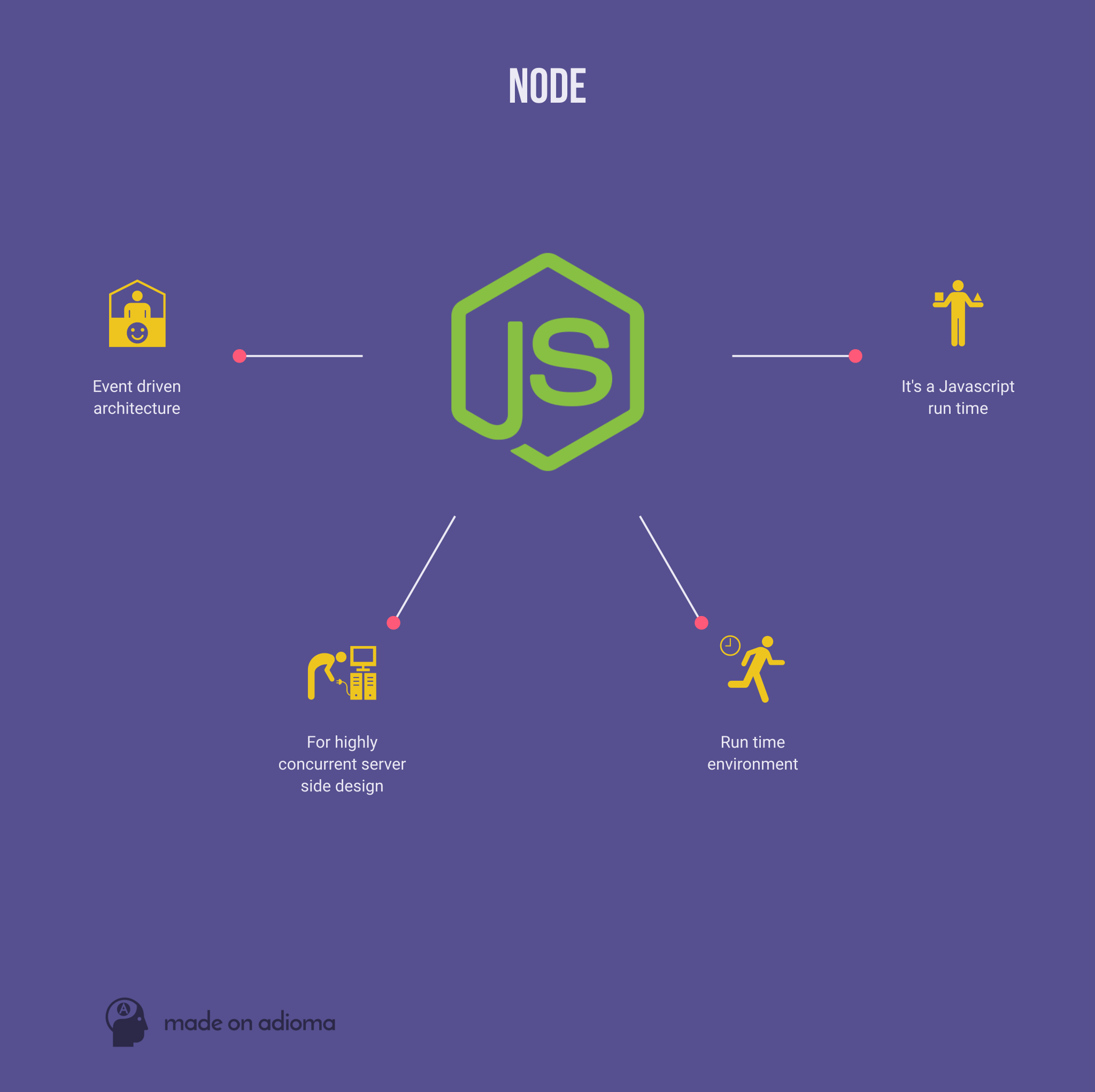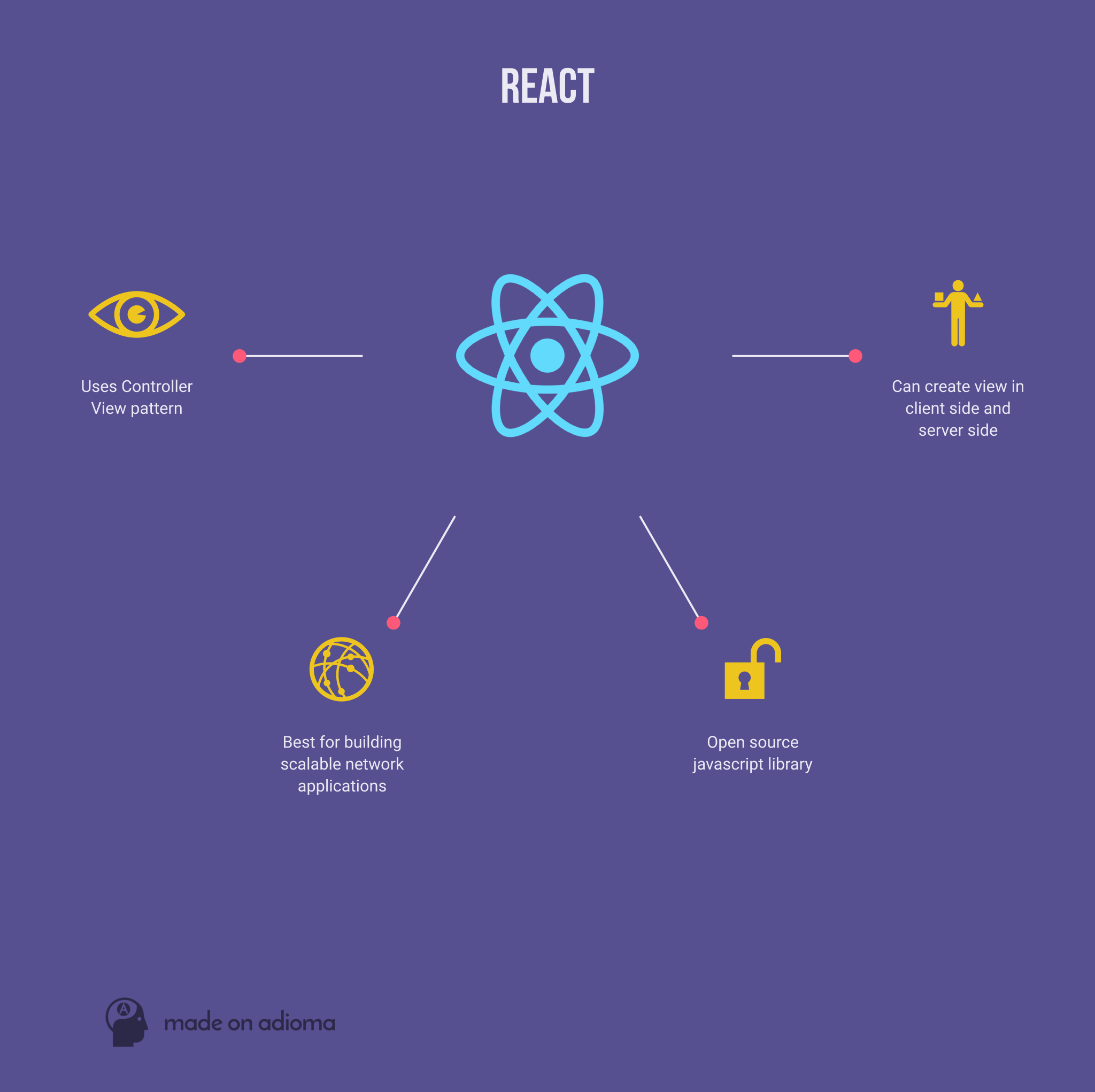The JavaScript war is at an all-time high. Developers across the JavaScript divide are debating on the best tool to use for Javascript applications. Pundits in this arena are drumming support for their favorite between Angular JS, and React JS. We’ll look at the similarities between these two frameworks and dive deeper into understanding the Javascript engine Node Js. What sets apart these three tools and how useful are they for Js software development?
Angular Js
2009 saw Google launch its “brainchild”, open source client-side web framework. Angular Js was released for angular developers with the primary purpose of addressing single page application creation challenges .
It simplifies development by providing a reliable framework for Client-side Model View Controller (MVC). Google is providing an official style guide and best practices, but it remains that the most comprehensive and popular AngularJS are from the AngularJS community itself.
Angular data binding
In Angular Js, the model and the view are linked to allow automatic data synchronization between the two. Sitepoint explains how the two way data-binding in Angular JS works. Any changes to the view are instantly propagated on to the model and vice versa.This property makes Angular app development less demanding as the programming model is simplified for the coder.
Angular modular development
Building modular rich client side applications that are well structured is now possible with Angular. Modules are created in separate Js files and are essential in separation of logic. They play a vital role of keeping the code organized. Examples of Angular Js modules include controllers, applications and services. Every part of the application is kept in a separate container to keep the code clean.
Why adopt Angular JS?
- The Angular architecture allows an easy and automatic data synchronization between the model view and the components.
- Angular templates are rendered just like the traditional plain HTML. Included extended HTML terminologies carry instructions on how to project the model into view.
- An inbuilt dependency injection subsystem allows the user to ask for dependencies. This is quicker and easier than having to look for them, which translates to faster Angular app development and testing.
- Angular is made to be testable from the initial development stages all the way up.
- Angular views are simple HTML pages. JavaScript controllers are responsible for the processing.
Trends with Angular Js
In 2015 Google initiated the Polymer project. It is relatively new and hasn’t really caught on. Some browsers still don’t support it. Polymer differs from Angular in that it is a tool for development of web components, while Angular is a whole self contained framework.
Some developers believe that Google is planning to slowly phase out Angular with this new entrant. That of course is pure speculation and only time can tell.Polymer is pushing for building of the application UI dynamically using reusable components.
Whether or not the relevance of Angular will diminish in the future is solely dependent on the decisions of Google and the ever changing trends.
React Js
React JS provides high performance client and server side rendering with a one-way flow for data binding. It is based on building reusable chunks of code which are components, more of a library, which makes it quite easy to work with.
React kind of gets out of the way of the developers design preferences; it doesn’t care whether the React app developer prefers Django or ASP.
React is more of a library than a framework. It can best be described as an application view that allows the programmer to utilize reusable components. It is composed of its own React libraries, tools, and solutions that developers can use to build their own Js framework.
React server side rendering
React boasts a unique feature that facilitates quick rendering of content, for better user interaction. A virtual React DOM allows both client side and server side rendering which decreases the page load time. Facebook, a high user traffic site employs React Js since it delivers amazing user experience, which is vital for a website of its caliber.
Re-usable components
React is built around development using components. Common react design elements can be broken down to individual components. React Buttons, fields, forms etc, can be saved and reused for a later time when the application developer intends to create another mobile or web UI project. This saves time and effort for the coder as they don’t need to write code again for the same components in the future.
Benefits of adopting React Js
-
It keeps a virtual React DOM which randomly updates parts that have been changed or those that need to be updated.
-
React allows both client and server side rendering.
-
It provides an option for pure JavaScript template creation.
-
React JS components are highly re-usable.
-
React comes with a small API. Beginners will find it easy to learn and start using it.
- React Native, an offshoot of React Js allows use of Javascript to write Native IOS applications.
Trends with React Js
Recently the JSX Compiler Service was deprecated as a JSX transformer tool, with the developers recommending the use of Babel REPL tool instead.
Node Js platform

Node is a Javascript run time powered by Google chrome V8 Javascript engine. It can be described as Javascript that has been given the ability to run on the computer, instead of the browser, like normal Javascript. This is made possible by the V8 JavaScript run time engine.Based on a module architecture, Node simplifies the development of complex applications.
It is works on an event-driven non-blocking IO model and is adapted for developing server side applications in JavaScript. Node Js allows you to build Utilities that you can concatenate and create JavaScript files with on your machine.
Benefits of Node Js platform
- It allows the use of the same Javascript for both the front end and back end development.
- Among many other functions, Node Js allows users to listen to network traffic, listen and reply to HTTP requests on the computer and access databases from the computer directly.
The downside of Node JS
-
Node uses event-driven approach to cater for implied scalability. Node Js developers have to work with the asynchronous execution model which compared to linear blocking I/O programming method is more tasking.
-
Node developers will have to deal with excessive nested call backs.
-
Being single threaded, it makes it harder for programmers to deal with concurrency.
-
It lacks of a standard library. Working without some of the utilities that are not provided for in libraries sometimes translates to less seamless programming.
Conclusion
While both React and Angular are opinionated to some degree, React happens to be “more accommodating” than Angular. Developers have the freedom to apply the React framework to any back-end they choose, it could be ASP, Django or Ruby on Rails, unlike Angular.
Building the web out of reusable components is something we have seen in the MVC pattern. The component way of building dynamic UI flow is the future. This is the trend, and the backbone of React Js that Angular Js needs to catch up on.
React Js’s learning curve is shorter than that of Angular Js. It takes just a few months of practice for new users to learn and be proficient in it, unlike the more complex Angular Js which takes much longer to understand at an expert level.
React Js is dynamic (and futuristic) and a less restrictive framework. Angular Js is mature and it’s the safest bet when you need to work with two way data binding.
Node is a powerful platform for creating client-side and server-side applications and gives you good service when you are developing apps that hold many open connections for a long time.












